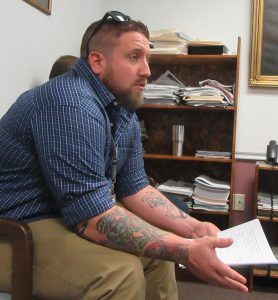While Tunkhannock Middle School students (top) learned about courthouse square from Historic Tunkhannock Walking Tour guide Sandra Vieczorek on Tuesday morning, representatives from the Victims Resource Center, including (above, from left) Janet MacKay, Marrisa Featherman, Clarice Colwell, and Marylou Kurlancheek were inside the courthouse marking Domestic Violence Awareness Month with the Wyoming County Commissioners.
Photos and Story by Rick Hiduk
Questions about the process by which disaster relief funds have been handled in the county and how the majority of residents whose homes were damaged in 2011 were eventually declared ineligible for programs designed to help them continue to dog the Wyoming County Commissioners. The topic once again dominated their regular public meeting on Oct. 17
Forkston area resident Louise Kling, whose home was flooded in 1996 and twice in 2011 returned with pointed questions about the county’s EMA and the Housing & Redevelopment Authority. The latter moved $500,000 that was supposedly earmarked for flood assistance to a non-flood-related project with a 2-to-1 vote by the commissioners at the their last meeting on Oct. 3. (Read about it here: http://www.endlessmtnlifestyles.com/?p=8672)
“I do not feel that the 2011 flood victims have justice yet,” Kling stated. “EMA and the Housing and Redevelopment Authority have let us down.”
The commissioners have been considerate of Kling’s plight and have publicly shared her confusion over processes that seem to be in a constant state of flux. Not only has it been determined during these discussions that rules vary greatly from one agency and type of grant to another, the criteria can also apparently change during the course of implementation.
Commissioner Tom Henry was quick to point out that a distinction needs to be drawn between Wyoming County EMA and the Housing & Redevelopment Authority, as well as between the roles of Gene Dziak and Lisa Hahn, the two who have respectively represented the agencies at recent meetings. Henry was defensive of Dziak’s efforts while admitting that Hahn’s requests of the board were still a bit baffling.
“Lisa was just involved with this last thing for flooding, and the story changed many times,” Henry remarked. “We have checked with the state to make sure that she did everything rights, and they say that she did.” (Hahn in fact presided over both the recent shuffling of funds to a low-income housing project in Nicholson and the announcement in the spring of the $2.4 million CDBG buyout of properties in Meshoppen.)
“Gene did help a lot of people get money,” Henry said of Dziak. “I want more than anything for you (Kling) to be covered. I wasn’t there when people told you differently.”
“If she (Hahn) does her job ‘very well,’ as she said at the last meeting, then why has she not been able to produce the evidence we have ask for? Why did we have to ‘use it or lose it’ unless she has spent it already?” Kling continued. “Do you have any proof that she had to have that letter by Friday (Oct. 6)?”
The commissioners stated several times in the past that they were not aware of the $500,000 earmarked for flood victims since January 2016 until Hahn approached them about sliding it to another column. They also agreed with Kling that they were not aware that their approval of the request was imminent until Hahn told them so at the previous meeting.
“I agree she didn’t tell us that. I want proof that it had to be done that Friday,” said Henry. “Most of what she is involved in is public housing. As a whole, I believe she is doing her job.”
“My understanding is that the money is usable until 2021, but they had to accept it by that Friday,” Commissioner Judy Mead added, with which Commissioner Ron Williams agreed.
Kling recommended an audit of the Housing Authority and wrapped up her polite discourse about flood relief with a final round of questions: “How many other grants has she had or does she have that you commissioners have signed off on? What is ‘repetitive flooding’ – one, two, three times? What if the rules change again and some of these people (who have already been denied) are found to be eligible? The money is now gone. Can some piece of that be saved for them? I don’t think that you as Wyoming County Commissioners have all the answers that you need.”
Henry related that a public meeting of the Housing and Redevelopment Authority is scheduled for 10:30 am on Nov. 22 and suggested that Kling and others attend and take their questions to the agency’s board.
“Tell them you want an audit,” Williams told Kling.
“We all agree,” Henry remarked.
Kling maintains that, while she is not giving up her fight for justice for flood victims, she is equally concerned about future inundations and the fact that little has been done to fix problems that exacerbated flooding in 2011 nor to mitigate the potential for a repeat of the disaster. There are several flood damaged structures remaining in the Forkston area about which nobody seems concerned, she noted.
“If these were located in Tunkhannock or someplace where people could see them, there would be a petition to tear them down,” Kling suggested, wondering if the buildings have even been inspected for seepage of sewage and heating fuel. Nearby Bradford and Sullivan counties are actively addressing their concerns about creek flooding, she explained. “How do we contact people to get the creeks cleaned out?”
Henry told her that he has reached out to the Bradford County Conservation District, the director of which, Mike Lovegreen developed a comprehensive stream mitigation plan in collaboration with DEP after the 2011 flood. There has been a series of public meetings there over the past few months to provide information for landowners as to the legalities of debris removal and DEP-approved measures that can be done with little or no government red tape.
The hold-up in the Forkston area has been two-fold, according to the commissioners. Williams blames the Army Corps of Engineers and the complications imposed by the agency, and Henry and Mead point to an overall lack of funding.
Despite numerous visits to the affected areas with state officials, the county has been told that the “cost to benefit ratio” does not add up for the state. Henry assured Kling that “cost” is a reference to properties and not to potential loss of life, which Kling feels is probable should the next flooding event occur at night.
“We’re even looking into Workforce Development to train people to get in there,” said Mead, who added that she intends to learn what she can from Lovegreen, whom she expects to see at a Northern Tier Planning Commission meeting this Friday.
Some Good News at the Wyoming County Prison
SMART Recovery counselor Ryan Taylor stopped by the commissioners meeting to provide a brief update on the Inside Out program designed to better prepare inmates for their return to their former homes and to avoid the issues that led to their incarceration. He said that the most successful participants to date have been females, three in particular who have completed the program and are “out and doing what they need to” to stay away from drugs and alcohol.
Henry related that people with whom he has spoken who have taken part in the program are proud of their achievements. “They are grateful and have new hope,” he added.
Taylor (above) hopes that additional counselors can receive the training needed (a 30-hour online course) to help him initiate a full SMART Recovery Program at the jail.
In additional prison news, Henry announced that there are currently only four inmates housed in other facilities but acknowledged that the situation can change rapidly.
The commissioners unanimously approved the hiring of new part-time corrections officers Cassandra Belmont and Charlene Nye.
Henry said that he and Warden Ken Repsher recently met with Luzerne County Correctional Facility interim Warden James J. Larson to discuss issues the two county’s facilities have in common, including how to properly handle intakes with mental health issues. Larson related to Henry that he felt that current psychoanalysis via close-circuit television is inadequate because the mannerisms and body language of the potential inmate cannot be properly gauged.
Williams noted that he has had similar discussions with officials in Lackawanna County, and Henry suggested that this could be the start of dialogues with other adjacent counties toward addressing the challenges faced by county jail officials.
Domestic Violence Awareness Month Proclaimed
Victims Resource Center executive director Janet MacKay (above, left) introduced counseling advocates Marrisa Featherman, Clarice Colwell, and Marylou Kurlancheek to the commissioners as they stood by for the reading of a proclamation marking Domestic Violence Awareness Month in Wyoming County. (below)





